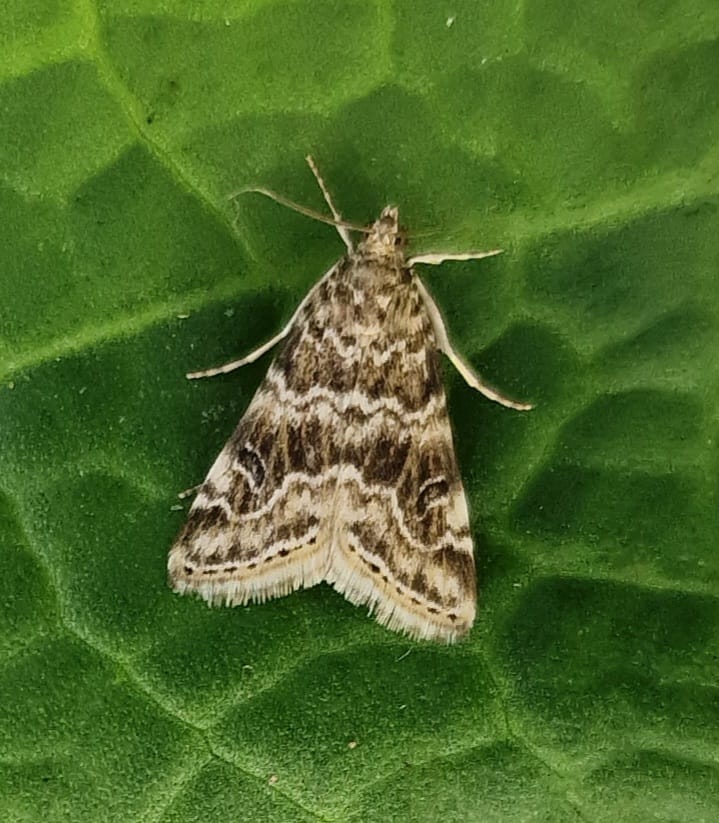Wings of Change: 40 New Moths Illuminate the Changing Environment

A Guide to the Pyralid and Crambid Moths of Britain and Ireland, a new book available from Atropos Books, features forty new moth species whose identification in the UK can be attributed to three key factors: climate change, horticulture trade imports, and increasing interest resulting in a better understanding of our fauna.
One of these new moths is the infamous Box-tree moth (Cydalina perspectalis). Originally from East Asia, it was first noticed in the UK in 2007 and is now naturalised; its caterpillar has since become a nuisance to gardeners and topiarists for defoliating box (Buxus) plants.
The new 500-page field guide by Mark Parsons and Sean Clancy brings together a wealth of knowledge about the identification, distribution, flight periods, and life cycles of Pyralid and Crambid moths.
It is the first in-depth review of these readily-encountered moths since the late Barry Goater’s seminal British Pyralid Moths was published by Harley Books in 1986.
Technical editor Mark Tunmore said: “Barry Goater’s book included 208 species – whereas this new book covers 248. That’s basically an average of more than one species a year since the publication of British Pyralid Moths in 1986.”
“So, the addition of these 40 species is partly due to a growth in interest in the subject but there are also an increasing number of species expanding their ranges as a result of climate change and migrating northwards into the British Isles.”
Tunmore adds that the creation of the book was, in part, made possible thanks to information gathered by thousands of moth enthusiasts over many years.
He said: “There’s been a massive surge in interest in moth recording. Books like Goater’s British Pyralid Moths have helped provide people with the tools to help them identify – and even discover new – moths. More recently, during lockdown, there was a noticeable increase in interest in the subject. People were buying moth traps and running them in their garden.”
Senior author, Mark Parsons, added “At the right time of year several of these species can be exceedingly numerous, such as the Satin Grass-moth Crambus perlella or the White-banded Grass-moth Crambus pascuella, which can be readily disturbed in their downland or pasture habitats as you walk through the grass. However, others such as the small, but rather beautiful, Scarce Crimson & Gold Pyrausta sanguinalis, may now be extinct in Britain, although it can still be found in Ireland. The elusive Scabious Knot-horn Eurhodope cirrigerella has recently been rediscovered after a gap of about 50 years. These moths really are found from the shoreline to the mountain top.”
The arrival, and identification, of so many new moth species admittedly made it challenging for the book’s authors to keep up-to-date with current information. For example, the Jack-fruit Moth Glyphodes caesalis, which originates from South Asia and was probably accidentally imported with foodstuffs, was confirmed as a new species in Britain and Ireland just as A Guide to the Pyralid and Crambid Moths of Britain and Ireland was going to press.
Tunmore explains: “It’s a never-ending process. Despite all that is known, there is still much to learn, and the early stages of some of our commoner species have not yet been found – we don’t even know what the caterpillars of some species feed on, for example. We hope this book will encourage greater interest and a new generation of observers to study these fascinating moths.”
The team behind this new book would like to thank all of those who helped make it possible – including a wide range of photographers, organisations, and moth recorders, as well as the Natural History Museum, London, which provided its expertise, historical records, and some moth specimens.
A Guide to the Pyralid and Crambid Moths of Britain and Ireland is available from www.atroposbooks.co.uk at the discounted price of £65.




